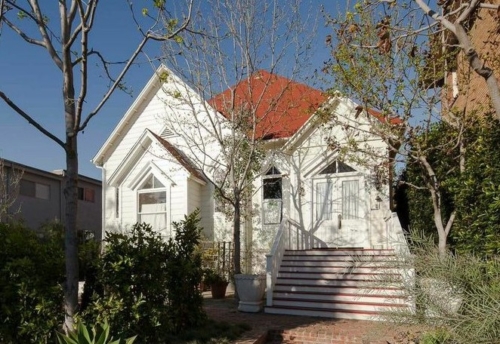Methodist Episcopal Church

- Known As
- Third Street Neighborhood Historic District, Gothic Revival
- Architect
- Unknown
- Built
- 1875
- Designated
- January 4, 1977
2621 Second Street is a building that has, like the city itself, undergone many changes yet still retained its essential character and interest. This Gothic Revival edifice—likely the oldest wooden structure in the city today—began life as the first church built after Santa Monica was founded in 1875.
Within months of the town’s founding a newly-formed Methodist Church society was already hard at work constructing this house of worship. Originally situated on two lots donated by town-founder Senator John P. Jones at Sixth and Arizona, the construction was a collaborative effort by church members.
Church members contributed funds towards the $683.98 cost of the building and offered their carpentry or glazing skills, or donated doors, lamps and seating. The original building was a modest rectangular wood frame structure with a steep gable roof, clapboard siding, an entry portico and a belfry. When it was dedicated on January 2, 1876 one observer remarked that “the Methodist Church Society now have a nice little church edifice…It is true that the building is not a very stately edifice, but it meets the present demands very well.”
When the Methodists faced declining members due to an economic bust facing the city in the 1880s, the building was moved to a more centrally-located lot at Fourth and Arizona in hopes of attracting more congregants. At that time a bell tower was added. Later, after the Methodists had rebounded, they found the structure too confining and built a new church on the same lot. The old church was moved to the back of the lot and used for meetings.
In 1899 the Methodists decided to donate the church to the South Santa Monica Methodist Church. Consequently, the building was moved to the newly developing area now known as Ocean Park. By this time the area already boasted several hundred cottages and a small business district and the church took its place among them on what is now Second Street.
The building then underwent several more changes. In 1923 a brick and masonry building was adjoined to the church and the edifice was sold. Its new owners—the Stephen Jackson Women’s Relief Corps—renamed the structure “Patriotic Hall” and used it for meetings. In the early twentieth century, almost everyone in Santa Monica was from somewhere else and this auxiliary of the Grand Army of the Republic was one of many clubs that sprang up to create a social fabric where none had existed before. As home to this group, the old church building continued in its role as a place for like-minded residents to come together.
 In 1972, the vacant and deteriorated structure was purchased by artist Helen Sheats, who converted it into a residence and artist’s studio. Her purchase of this building saved it from demolition. Sheats used the former belfry as her meditation room and created the stained glass windows, which remain today.
In 1972, the vacant and deteriorated structure was purchased by artist Helen Sheats, who converted it into a residence and artist’s studio. Her purchase of this building saved it from demolition. Sheats used the former belfry as her meditation room and created the stained glass windows, which remain today.
Architect Anne Troutman bought the church in 2003, and reconfigured the building as her family residence. Many original architectural elements were restored, the building totally rehabilitated, and residential features were newly created. A handsome structure near the center of the old church hall accommodates a kitchen, storage cabinets, bookshelves, a bathroom and a loft. The elegant design and wood cabinetry of the new interior blends artfully with the vintage features of the original old church. If you look carefully at the floors, nail holes and exterior rooflines, the layers of history of the building are revealed.
The Methodist Episcopal Church is a particularly potent symbol of community-building in the days when Santa Monica was young. The church is also a remarkable model of adaptive reuse, showing how old buildings preserve the stories of our city while finding new use for modern times.
This property was featured most recently in the Conservancy’s Third Street Neighborhood Historic District Tour. Our brochure containing information about the history and architecture of this area is available for free download here.
Sources:
- David Gebhard and Robert Winter, Los Angeles: An Architectural Guide (Gibbs-Smith Publisher: Salt Lake City, 1994).
- Evening Outlook, January 5, 1876.
- Santa Monica Landmarks Tour (City Planning Division, City of Santa Monica: Santa Monica, August 2003).
- Paula Scott, Santa Monica: A History on the Edge (Arcadia Press: Charleston SC, 2004).
- Staff Report on First Methodist Church, 2621 Second Street, City Planning Division, Santa Monica.